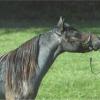Purebred Arabian with Cream is Claimed
Forums
Hey Kelpie! So glad to see
Hey Kelpie! :bounce So glad to see you here. ^_^ I have to say I would also be very amused if every Friesian magically became Ee. ymwhisle
Here's another crazy mitochontrial chart showing how everywhere the domestic horse breeds are.
http://i872.photobucket.com/albums/ab28…
Plus there are all the problems that occur with severe inbreeding and 'pureblood' after awhile of closed stud books. Popular lines can weed out diversity and concentrate genetic problems. Allowing approved outside animals into the genepool isn't bad genetically speaking, keeps diversity up and works if measures are taken to keep genetic disorders out. I've said it before but being purebred is an overrated illusion. And we have the scientific studies to prove it. :booty
Quote:Threnody "Allowing
[quote]Threnody "Allowing approved outside animals into the gene pool isn't bad genetically speaking, keeps diversity up and works if measures are taken to keep genetic disorders out. I've said it before but being purebred is an overrated illusion. And we have the scientific studies to prove it." [/quote]
As in the Dalmatians to isolate and remove a specific problem??
I do know Dobes have a big problem with inbreeding now- I am not sure how many grandparents my bitch has but it is not the accepted number!
Yup, that's an example. ^_^
Yup, that's an example. ^_^ I wish the dals who were bred back to that one pointer were more accepted. They look like and act like pure dal and it's a chance to reduce or even remove the uric acid disorder from the breed. And there is no way to remove it from within the purebred lines because all the dals are homozygous for it. It's frustrating that it's being met with such opposition. Especially since the idea of line purity is held in higher regard than improving a breed's overall health. :(
Thanks for the welcome
Thanks for the welcome Threnody, and the chart! (I'm thinking I need to actually make a "horse charts" folder on my computer because they are beginning to pile up.) I could definitely see some of the closely related groups (like the shetland-mini-icelandic-hackney pony-welsh group, or "cute group"), but some were really surprising. Akhal-Teke and Lippizaner?!
From what I found it is
From what I found it is estimated to occur around every 300 - 600 generations in humans, and for horses in this article, http://www.pnas.org/content/99/16/10905…
"This finding indicates a minimum mutation rate of 1 mutation per 100,000 y and a maximum rate of 1 mutation per 350,000 y, respectively."
Horses have only been domesticated for around 4-6 thousand years so none of the mtDNA mutations are very recent.
From what I can interpret the article determined that horses were likely domesticated from several groups of horses who already had certain mtDNA mutations unique to their specific populations. When horse domestication started intermixing these groups the mutations dispersed into other populations that lacked certain mutations.
So the Arabs likely have a mixing of mutations from interbreeding with other animals from various groups. I could be reading it wrong but that's what I got out of the article.

I generally lurk in forums
In reply to by Daylene Alford
I generally lurk in forums for a long time before I actually get drawn in enough to post and this thread did it for me. Many of you are also on HorseGroomingSupplies and I'm there as Kelpie too.
[quote=Third Peppermint]I think I remember a paper that checked mitochondrial DNA of Lipizzans and they basically found out that the "pedigrees" are worthless. A HUGE percent of the horses DNA didn't match their supposed ancestry. It'll be harder to sneak horses in now days, but yeah. Who knows what happened back in the day?[/quote]
This would not surprise me one bit. I doubt any horse breed has been bred completely pure except for Icelandics (as of ~1,000 years ago) no matter what the crazy arab fanatics say.
[quote]Have you ever heard of breeding groups like Al-Khamsa, Blue List, and Asil? Someone actually went through all the studbooks and listed the horses they thought were pure and excluded the other 90%. Seriously - that is what they did.[/quote]
When I first ran across the Asil folks I was blown away. "Really? There are crazy arabian fanatics who are even [i]crazier[/i]?!"
[quote]had reckoned without the roars of anger this gathered on ANB- actually, I was surprised at how heated it got so quickly as they tend to be a lot of cliquey, abuser supporting do gooders most of the time.....[/quote]
I wasn't surprised at all. Starving horses is a-okay (as long as you are in the clique), but the nuttier ones seem to hold on so tightly to this strange identity as owning the purest breed in the world that any hint at impurity is a huge threat.
Note: I say all of the above as an arabian owner. ABN was quite an eye-opening experience when I joined it. I figured it would be a good idea since I had a (technically 3/4) arabian...little did I know it would be the Rapture Ready of the horse world. O.o
Also, if I were promoted to godhood I would immediately set about trolling the stricter purebreed fanatics by popping colors into some breeds where said colors don't exit or cause feelings of faintness in owners when they appear. I think my first move would be to make every friesian stallion Ee and then sit back with a bag of popcorn and wait until next foaling season.
Mwahaha.